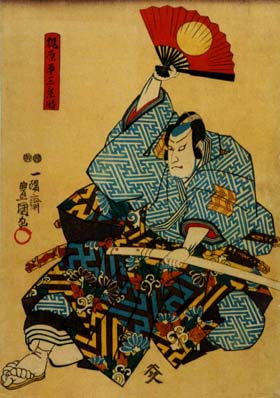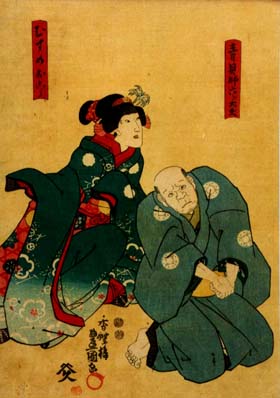Monday, April 20th--Caitlin has really been wanting to go to a kabuki play while we are here. Kabuki tickets are expensive, but if you try to get in on standby, it is very reasonably priced. It was rainy today, so it seemed like a good day to test our luck at getting in to a play.
We decided that the boys were probably too young to sit quietly through the entire play, so it was just Caitlin, Tayla, and Mom who went to the Kabukiza Theatre. The two girls are standing in front of the theatre in the above picture. The building is very beautiful.
While we were waiting in the standby ticket line, we saw two sumo wrestlers get out of a car and walk into the theatre. One of the wrestlers was Hakuho--our family's favorite sumo wrestler! I scrambled for my camera, but couldn't get it out quickly enough to snap a picture of him. I did get the other sumo wrestler, though. Don't know who he is....
Outside of the theatre, there were posters advertising the different plays that are currently available. Caitlin read the storyline for each play that is currently being performed and chose to watch the play titled Ishikiri Kajiwara.
Kabuki has been a form of art in Japan for over four hundred years. It has a slightly risqué past, but has survived throughout the end of the samurai period as well as the reformation of the Meiji Restoration. It has always been popular, and reflects not just the fashions and cultural tastes of the people, but also the political and socio-economic conditions of the time period that the plays represent. In attending this play today, we are experiencing an important cultural and historical part of Japan!
We easily got in on standby, and we able to get good seats in the back--where the people on standby are allowed to sit. We had regular theatre seats in our section, but the people who paid for their tickets in advance had to sit on cushions. This is a picture of the inside of the theatre of the stage before the play started. Photographs are strictly prohibited during the actual performance.
The setting of the stage was beautiful! Cherry blossoms lined the back of the stage. The stage setting never changed throughout the entire play, which lasted for about 1 1/2 hours.
The costumes of the performers were gorgeous. Rich, embroidered fabric was used to make the traditional kimonos that the actors wore. Sometimes, people dressed in black from head to toe would come on stage and set out props or take down props. These people clothed in black are not a part of the storyline and are supposed to be ignored by the audience. However, they were fun to watch! Plays in America do not have black-clothed people scurrying around the stage and so it was fun for us to watch them.
The actors in kabuki plays are all men. There was one woman character in the play that we watched, and it was amusing to watch "her" knowing that she was really a man.
The play was performed in Japanese, of course. Caitlin got a translator and periodically told us what was going on. The actors didn't move around the stage a lot, they mainly just stood there and recited their lines.
Here is a summary of the play that we watched:
Ôba Saburô and his bombastic villainous brother Matano Gorô, who are both Heike warriors, are at a shrine in Kamakura celebrating their recent victory over the enemy general, Yoritomo, when Kajiwara Heizô, who also fought in the same battle, enters and joins them.
An elderly man and his daughter then appear and approach Ôba. Old Rokurôdayû wishes to sell a precious sword in his possession to help his daughter Kozue, and asks Ôba to buy it. Just as Ôba is about to go ahead, his brother objects and says that before anyone parts with 300 gold pieces he wants the sword examined. Kajiwara, who is known to be an outstanding swordsman, agrees to examine the sword. As he does so, he notices not only its excellence but sees something on the hilt that indicates the sword is a treasure of the enemy Genji, but he keeps that information silent. Kajiwara gives the sword his unqualified approval, and the sale is about to through again when Matano says that if it doesn't cut well it is more useless than a rusty fish knife, and insists that it is tested-by cutting two condemned prisoners in half.

The prison official reports that unfortunately there is only one prisoner currently under the death sentence, so Ôba says that he cannot buy the sword and readies himself to leave. Rokurôdayû, however, is desperate to sell the sword because he is secretly a Genji sympathizer and he needs the money to give to the Genji cause, so he offers himself as the second body, on the understanding they give the money to his daughter after his death. Matano is satisfied and plans to do the slicing himself, but Kajiwara intervenes and says he will test the sword. The condemned man is brought in and lain on top of Rokurôdayû. Kajiwara brings down the sword with precision, but only the criminal is killed. Rokurôdayû is still safely in one piece. Matano is disgusted that the sword has failed its reputation and leaves with Ôba. Kajiwara then reveals that he deliberately gauged the power of his stroke so that Rokurôdayû would not die. He, Kajiwara, recognizes the power and significance of the sword, and will buy it for himself, for he is also secretly a Genji sympathizer. And to prove the sword is in no way defective he brings it down on a stone water trough, cutting it clean in two. All three are delighted with the outcome and leave for Kajiwara's mansion to settle payment. The end.
Here's what the girls thought of the kabuki play:Caitlin: I liked it! I liked the way they designed the make-up. The impetuous guy had red make-up to show that he was rude but no one else had red make-up 'cause they weren't as rude as he was. I liked the way the stage was designed with the main stage and the two boardwalks. And, we saw Hakuho outside as we were waiting for our tickets.
Tayla: I thought kabuki was really cool. I thought the theatre was pretty. Seeing Hakuho was cool. I liked the play, but it got really drawn out in some parts. It was fun. I'm glad I went.






No comments:
Post a Comment